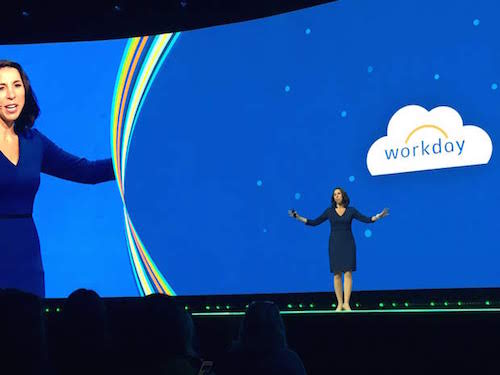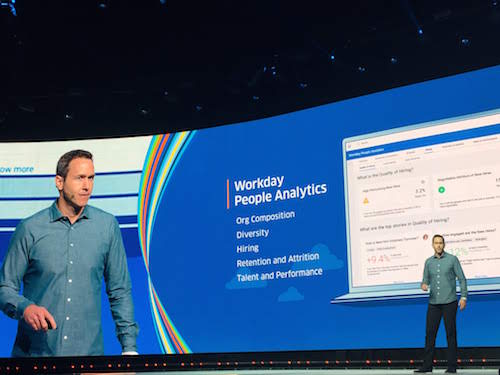Las Vegas – Continuing to build on last year, software as a service (SaaS) vendor Workday Inc. has announced more machine learning and artificial intelligence solutions for its human capital management (HCM) system with a focus on predictive analytics and new ways to analyze important issues and skills that make up a company’s workforce.
Workday announced a new addition to its HCM system at Workday Rising in Las Vegas on Tuesday, a machine learning-powered skills cloud that is set to help organizations more easily recognize, identify, and organize job skills of current and potential employees.

According to the press release, “using its skills cloud as a foundation in HCM, Workday aims to help customers easily tap talent inside and outside of their organizations.”
Barbry McGann, SVP of products at Workday said on stage, “We are on a mission to help global organizations bridge the talent gap…by applying machine learning to every aspect of talent management,” noting that Workday sees skills as part of its core effort to bridge this gap, calling them the “new currency” between supply and demand for talent.
AI helps identify skills needed to grow your business
Cristina Goldt, vice president of HCM products for Workday told IT World Canada that this product came about because of problems faced by its customers struggling to understand the data collected about the skills they have and the skills they need to grow their businesses.
“There are multiple descriptions for every skill that exists, and skills are constantly changing, with new ones emerging and others becoming obsolete,” stated the release, “Workday found that common skills can have up to 20-plus synonyms.” Goldt says that by applying machine learning algorithms Workday has created a “common language for skills.”
The skills cloud updates and recommends relevant or related skills when individual users enter them into the HCM system. For example, said Goldt, showing that ‘patient management’ is related to ‘urgent care’ and ‘clinical trials’ for nurses.
According to the release, Workday has already applied machine learning to its own data and combined with seed data from O*NET OnLine, a government agency in the U.S. that provides access to occupational information, to reduce the number of skills into something more manageable.
McGann told the audience that with this partnership, Workday has reduced over 200 million user-entered skills down to a manageable 55,000 verified skills.
Workday argues that it is in a unique position, with the machine learning algorithms and access to 1 million skills from its customer community with more than 31 million workers to simplify skills language.
“This will make life more efficient for recruiters, managers and HR professionals,” says Goldt, she states that Workday also sees future uses for this technology to drive data innovation, in areas such as talent matching, and finding learning development opportunities for employees.
People Analytics turns data into a story
Workday also announced People Analytics, a new feature that uses machine learning and augmented analytics technologies to find and predict important trends in a business and give executives, managers and human resource (HR) professionals any easier way to view and understand these issues, stated the press release.

“It’s a way to predict the most important issues in a workforce,” Peter Schlampp vice president of Workday Analytics told IT World Canada, “It uses augmented analytics and machine learning with automated pattern detection, and graph processing for prioritizing those issues.”
Some of the data that People Analytics will collect and report on include: where a company might be struggling to hire, learning from things like performance, what drives attrition and even diversity within the workforce. The platform specifically looks as five categories, including diversity, hiring, retention and talent.
“Most executives don’t do analysis no matter how easy and accessible it is, there’s simply too much data and it can be a challenge…these stories dig deeper into data can explain why things are happening, it gives the essential information needed to make business decisions,” says Schlampp.
He also explains that it turns that data into a “natural language story that is easy to understand.” For example, if a business has recently had a number of employees quit, People Analytics will take that data and provide a detailed ‘story’ about why that might be happening.
Managers can view those findings in a dashboard that shows the five topics, and top personalized stories about the business under each topic. The platform is not only personalized to each company but for each specific user. The stories explain why the company might be having retention issues, by analyzing data collected on contributing factors such as compensation, manager issues or sales.
This new platform comes after Workday’s July acquisition of San Francisco-based Stories.bi, which automates data analysis using graph artificial intelligence. Schlampp says the tool used to create People Analytics is a combination of Stories’ tools, other various programs, as well as over three years of HCM analytics data collected by Workday.
While this is the first place Workday is using augmented analytics, it has future plans to bring it to all its products and services. The automated platform will be sold separately from Workday HCM, but included as part of Prism Analytics, it will be available for early adopters in the spring of 2019, and generally available later in the year for the rest of Workday customers.
Workday also announced at the conference that since its acquisition of Adaptive Insights in June, it has, as of Monday, gone live on its Adaptive Insights Business Planning Cloud and has also announced future plans for using it as a predictive planning solution to further strengthen collaboration between finance and HR for its customers.
The keynote focused heavily on predictive analytics and using AI and machine learning to further develop products like virtual assistants and more.
